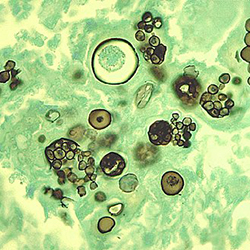By Ethan Covey
Surveillance data for coccidioidomycosis, histoplasmosis and blastomycosis indicate the COVID-19 pandemic likely affected care-seeking behavior, diagnosis and public health reporting of these diseases (MMWR Morb Mortal Wkly Rep 2024;73:239-244).
“There are a lot of unknowns about the impact of the COVID-19 pandemic on fungal infections,” said Samantha Williams, MPH, an epidemiologist in the Mycotic Diseases Branch at the CDC. “For coccidioidomycosis, histoplasmosis and blastomycosis, this report shows some unusual findings compared with what we had typically seen prior to COVID-19."
Data from 2019 through 2021 showed that coccidioidomycosis and histoplasmosis case counts declined in 2020 compared with 2019, and then increased in 2021. In addition, a high 2021 blastomycosis case fatality rate of 17% and atypical 2020 seasonality across diseases were observed.
“Surveillance is critical to improve our understanding of these diseases and monitor trends over time,” Ms. Williams said. “Surveillance allowed us to see deviations in these trends in the 2020 and 2021 data, providing important clues about the impact of the pandemic on these diseases and reporting. We need broader surveillance across the board, and the more we can expand the number of states reporting these diseases, the more accurate our picture of national cases will be.”
Improving surveillance in the future may also help fill in gaps and allow for more detailed analysis.
“We are also exploring opportunities to enhance surveillance data to gather more information,” Ms. Williams said. “With these enhancements, we could potentially explore trends in patient characteristics, the path to diagnosis, subsequent treatment and outcomes.”
However, Ms. Williams stressed that cases cannot be reported if they are not diagnosed.
“Encouraging patient awareness and health-seeking behaviors and increasing fungal disease diagnostics among healthcare providers builds a more robust surveillance system. Integration of fungal diseases into broader public health efforts for respiratory diseases can help to increase overall awareness and knowledge to improve early diagnosis.”
Regarding the findings of the new report, Ms. Williams noted that additional study could help answer lingering questions.
“It would be beneficial to explore the substantial increase in histoplasmosis cases from 2020 to 2021. While some of the difference is likely due to the pandemic, the considerable change suggests that there might be multiple factors contributing to the increase.”
Ms. Williams added: “Similarly, additional insights into the concerning blastomycosis case fatality rate in 2021 would be useful to assess if certain populations were affected more than others. The report also showed continued racial and ethnic disparities that have been documented in previous studies. We need to better understand how social determinants of health may be driving these differences to help develop effective and meaningful public health interventions.”
Ms. Williams reported no relevant financial disclosures.




